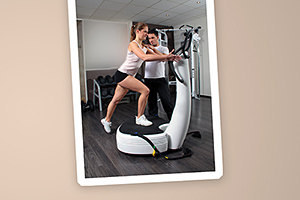Whole-body vibration (WBV) therapy is a common modality for fitness, performance and conditioning. However, OSHA has recognized that exposure to excessive levels of vibration has adverse health effects, including low back pain. Let's look at how and when vibration can be applied in clinical practice, and see if this gap can be bridged.
Clearly, vibration therapy needs to be applied like all modalities: after thoughtful evaluation with the appropriate duration, intensity and site of application.
The Basics of WBV
 Dosing WBV is a function of frequency (Hz) and amplitude of each wave. For MSK conditions, the frequency ranges from 10-55 Hz, with the sweet spot in most studies being approximately 30 Hz. Amplitude is the displacement of the platform per oscillation.
Dosing WBV is a function of frequency (Hz) and amplitude of each wave. For MSK conditions, the frequency ranges from 10-55 Hz, with the sweet spot in most studies being approximately 30 Hz. Amplitude is the displacement of the platform per oscillation.
Combining Hz and amplitude determines the acceleration or g force transmitted to the patient. For example, 1 mm displacement at 10 Hz is 0.4 g of force, whereas 1 mm displacement at 50 Hz is 10 g (Note: g = Earth's gravitational acceleration or 9.8 m/s2).
Clinical Tip: It is important to assess both the acceleration and frequency of your WBV platform to remain within safety standards. For example, the International Safety Threshold Limits for occupational exposure to vibration at 30 Hz, acceleration of 2 g, is up to one minute per day; while at 0.3 g at 30 Hz, it can be maintained safely for up to eight hours/day.
Many commercially available WBV plates can generate over 15 g. While the bones, joints and muscles of highly trained athletes may tolerate such loads, the soft brain within the skull is less adaptable. The cranium may not be as forgiving and the impact of a "good workout" on the vibration plate may not be evident for many years.
Thompson contends: "Until it is clear that the benefits of high-intensity vibration outweigh its adverse effect consequences, physicians and other healthcare providers should consider low-intensity (<1 g) treatments for their patients."
Clinical Benefits
WBV training has been shown to improve balance, bone density and muscular activation. In fact, from a nano view, vibration opens ion channels between cells, changing the mechanical force to a biochemical stimulus, which in turn creates a cellular or genetic response.
Low-magnitude mechanical signals target multiple tissues within the neuromuscular system including mesenchymal stem cells, osteoblasts, osteocytes, adipocytes, osteoclasts, myocytes, and neurons ,making it a potent therapeutic agent. Therefore, from a nano perspective, low-intensity vibration is better than high-g forces.
Clinical Tip: Low-intensity vibration (LIV) is an excellent choice for the frail, elderly and deconditioned patient. Kept under 1.0 g, it is safe, and improves muscular strength, balance and bone density.
Osteoporosis is a major health concern for all seniors, especially women. However, bone loss can also be the result of cancer or metabolic disease. The application of LIV for these patients is effective and beneficial.
Leung followed elderly subjects for 18 months with LIV. The protocol was standing, knees straight, on a platform with vertical vibration at 35 Hz, displacement of <0.1 mm, creating acceleration of 0.3 g, for 20 min/day, five days/week. After nine months, muscle strength and balance improved, as did psychosocial indexes. Bone density changes were more noticeable at 18 months.
Vibration platforms can displace vertically with the g forces directed upward through the hips; or in an asynchronous alternating side-to-side displacement in which forces are buffered by joints. Force transmittal is significantly reduced in a bent-knee posture, which benefits the cranium – a tip especially useful for athletes exercising on platforms with high g forces.
Conversely, standing with the knees slightly flexed and core engaged maintains good force transmittal; and keeping the knees locked and stiff maximizes the force transmitted throughout the body.
Vibration for Posture Correction
As doctors of chiropractic, we own posture and alignment. LIV can be easily implemented into any practice as a postural correction and neuromuscular conditioning modality. Here are the patient instructions to make an LIV session a postural correction tool.
- Teach the patient neutral sagittal-plane alignment standing – or as best as they can get.
- Instruct them in Janda's short-foot posture standing. Engaging the gluteals helps maintain short-foot posture and stabilizes the core, allowing better force transmission.
- Teach frontal-plane alignment of the hips, shoulders and head.
- Elevate the chest, drop the shoulders and engage the mid- and lower trapezius.
- Maintain eyes level.
- Lengthen the spine from the top of the head.
- Keep the arms relaxed and in anatomical neural.
Each session is 10 minutes with LIV acceleration kept less than 1 g. This ensures the total vibration load is well within the safety zone for all age groups and body structures for up to eight hours a day based on international standards. Adding this protocol to every visit after the patient gets adjusted is the optimum opportunity to allow the adjustment and postural correction to set.
Take-Home Points
Whole-body vibration will continue to be an integral part of physical rehabilitation and sports conditioning programs. However, supersizing your vibration plate is not necessary since when it comes to acceleration forces on the body, more is not better. Excellent gains in bone density, balance, strength and even posture can be achieved by keeping the vibration low and slow.
Resources
- Cariati I, et al. Whole body vibration improves brain and musculoskeletal health by modulating the expression of tissue-specific markers: FNDC5 as a key regulator of vibration adaptations. Int. J Mol Sci, 2022;23:10388.
- MarÃn-Cascales E, et al. Whole-body vibration training and bone health in postmenopausal women, a systematic review and meta-analysis. Medicine, 2018;97:34.
- Muir J, et al. Safety and severity of accelerations delivered from whole body vibration exercise devices to standing adults. J Sci Med Sport, 2013 Nov;16(6):526-31.
- Pagnotti GM. Suppression of cancer-associated bone loss through dynamic mechanical loading. Bone, 2021;150:115998.
- Rajapakse CS, et al. The efficacy of low-intensity vibration to improve bone health in patients with end-stage renal disease is highly dependent on compliance and muscle response. Acad Radiol, 2017 Nov;24(11):1332-1342.
- Rubin C, et al. Transmissibility of 15-Hertz to 35-Hertz vibrations to the human hip and lumbar spine: determining the physiologic feasibility of delivering low-level anabolic mechanical stimuli to skeletal regions at greatest risk of fracture because of osteoporosis. Spine, 2003 Dec 1;28(23):2621-7.
- Stania M, et al. The application of whole-body vibration in physiotherapy - a narrative review. Physio Int, 2016 Jun 1;103(2):133-145.
- Thompson WR. Vibration therapy: clinical applications in bone. Curr Opin Endo Diab Obes, 2014 Dec;21(6):447-453.
Click here for more information about Donald DeFabio, DC, DACBSP, DABCO.





